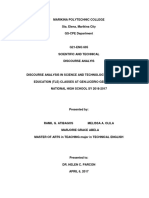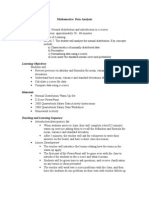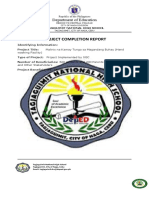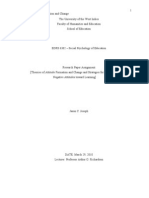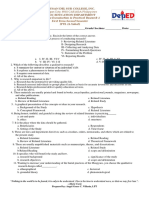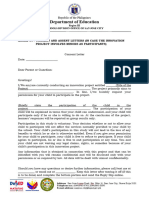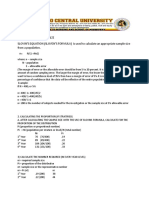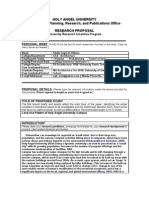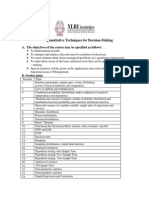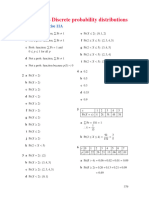0 ratings0% found this document useful (0 votes)
559 viewsSample Size Thru Slovin's PDF
Sample Size Thru Slovin's PDF
Uploaded by
Cyndy VillapandoSlovin's formula allows researchers to calculate the needed sample size to survey a population with a desired level of accuracy and confidence. The formula uses the total population size (N), desired error tolerance (e), and calculates the number of samples (n) needed. For example, if surveying a population of 2,500 students with a 5% margin of error, the needed sample size is 345. The formula provides a way for researchers to get accurate results when surveying the entire population is not feasible.
Copyright:
© All Rights Reserved
Available Formats
Download as PDF, TXT or read online from Scribd
Sample Size Thru Slovin's PDF
Sample Size Thru Slovin's PDF
Uploaded by
Cyndy Villapando0 ratings0% found this document useful (0 votes)
559 views8 pagesSlovin's formula allows researchers to calculate the needed sample size to survey a population with a desired level of accuracy and confidence. The formula uses the total population size (N), desired error tolerance (e), and calculates the number of samples (n) needed. For example, if surveying a population of 2,500 students with a 5% margin of error, the needed sample size is 345. The formula provides a way for researchers to get accurate results when surveying the entire population is not feasible.
Original Title
SAMPLE SIZE THRU SLOVIN'S .pdf
Copyright
© © All Rights Reserved
Available Formats
PDF, TXT or read online from Scribd
Share this document
Did you find this document useful?
Is this content inappropriate?
Slovin's formula allows researchers to calculate the needed sample size to survey a population with a desired level of accuracy and confidence. The formula uses the total population size (N), desired error tolerance (e), and calculates the number of samples (n) needed. For example, if surveying a population of 2,500 students with a 5% margin of error, the needed sample size is 345. The formula provides a way for researchers to get accurate results when surveying the entire population is not feasible.
Copyright:
© All Rights Reserved
Available Formats
Download as PDF, TXT or read online from Scribd
Download as pdf or txt
0 ratings0% found this document useful (0 votes)
559 views8 pagesSample Size Thru Slovin's PDF
Sample Size Thru Slovin's PDF
Uploaded by
Cyndy VillapandoSlovin's formula allows researchers to calculate the needed sample size to survey a population with a desired level of accuracy and confidence. The formula uses the total population size (N), desired error tolerance (e), and calculates the number of samples (n) needed. For example, if surveying a population of 2,500 students with a 5% margin of error, the needed sample size is 345. The formula provides a way for researchers to get accurate results when surveying the entire population is not feasible.
Copyright:
© All Rights Reserved
Available Formats
Download as PDF, TXT or read online from Scribd
Download as pdf or txt
You are on page 1of 8
SLOVIN’S FORMULA
• If you take a population sample, you must use a
formula to figure out what sample size you need
to take. If a sample is taken from a population, a
formula must be used to take into account
confidence levels and margins of error. When
taking statistical samples, sometimes a lot is
known about a population, sometimes a little and
sometimes nothing at all.
• When it is not possible to study an entire
population (such as the population of the
Philippines), a smaller sample is taken using a
random sampling technique. Slovin's formula
allows a researcher to sample the population
with a desired degree of accuracy.
Slovin’s Formula…
• It gives the researcher an idea of how large his sample
size needs to be to ensure a reasonable accuracy of
results.
• That’s when you can use Slovin’s formula to figure out
what sample size you need to take, which is written as
n = N / (1 + Ne2)
• where
• n = Number of samples,
• N = Total population
• e = Error tolerance
SLOVIN’S FORMULA…
• Sample Calculation:
1. A group of students want to know the age of
students in a high school but do not have the resources
to survey an entire population of 2,500. If they want to
use a sample with a 5% margin of error, what should
their sample size be?
Given:
N = 2,500
e = 5% = 0.05
Required: n = ?
Solution:
n = N / ( 1 + (N*e^2))
n = 2500 / ( 1 + (2500*.05^2))
n = 2500 / 7.25
n = 344.83 ~ 345
SLOVIN’S FORMULA…
2. What sample of a population of 1,000 people you
need to take for a survey on their soda preferences.
Step 1: Figure out what you want your confidence
level to be. For example, you may be happy with a
confidence level of 95 percent (which will give you a
margin of error of 0.05), or you may require a
tighter or better accuracy at the 98 percent
confidence level (which produces a margin of error
of 0.02).
SLOVIN’S FORMULA…
Step 2. Plug your data into the formula. In this
example, we’ll use a 95 percent confidence level
with a population size of 1,000.
n = N / (1 + N e2)
1,000 / (1 + 1000 * 0.05 2)
285.714286
SLOVIN’S FORMULA…
Step 3: Round your answer to a whole
number (because you can’t sample a fraction of
a person or thing!)
285.714286 = 286
SLOVIN’S FORMULA…
"A researcher plans to get 588 sample units
from population N using a 4% margin of error.
What is the value of N?"
SAMPLE SIZE
SAMPLE SIZE DEPENDS ON DIFFERENT FACTORS:
1. COST & TIME CONSTRAINT
2. DEGREE OF PRECISION NEEDED
a. LARGER SAMPLES WILL PROVIDE MORE PRECISED
ESTIMATES OF THE POPULATION PARAMETER
b. MORE HETEROGENEOUS POPULATION REQUIRE
LARGER SAMPLE SIZE
c. THE LARGER THE SAMPLE , THE MORE NARROW
THE CONFIDENCE INTERVALS
d. THE MORE REPRESENTATIVE THE SAMPLE,THE
MORE VALID THE CONCLUSIONS OF THE SURVEY
You might also like
- 500 Data Science Interview Questions and Answers - Vamsee Puligadda PDFDocument141 pages500 Data Science Interview Questions and Answers - Vamsee Puligadda PDFFranco Abanto75% (8)
- Colegio de Dagupan Dissertation Standard Contents & Formatting RequirementsDocument39 pagesColegio de Dagupan Dissertation Standard Contents & Formatting Requirementsmarnella de guzmanNo ratings yet
- Statistics WT Lab Fe LecDocument122 pagesStatistics WT Lab Fe LecJisel-Apple Bulan100% (1)
- Computer-Based Strategic Intervention Materials, An Alternative Delivery Mode For The Improvement of Teaching English World LiteratureDocument1 pageComputer-Based Strategic Intervention Materials, An Alternative Delivery Mode For The Improvement of Teaching English World Literaturesheng cruzNo ratings yet
- 4.3 Observation GuideDocument10 pages4.3 Observation GuideRodel AriolaNo ratings yet
- Advanced Human Growth and DevelopmentDocument6 pagesAdvanced Human Growth and DevelopmentSilvy AmaliaNo ratings yet
- Slovin FormulaDocument3 pagesSlovin Formulameraniikaara50% (2)
- Chapter 3Document27 pagesChapter 3lianne_lacsamana100% (1)
- Research FormatDocument82 pagesResearch FormatDyuli JimenezNo ratings yet
- Brigada Eskwela 2014 Evaluation FormDocument4 pagesBrigada Eskwela 2014 Evaluation FormEllen Esguerra BasitNo ratings yet
- Deped Format of A Project Proposal For Innovation in SchoolsDocument7 pagesDeped Format of A Project Proposal For Innovation in SchoolsMA. CHONA PILONGO100% (1)
- Letter For Final Oral DefenseDocument1 pageLetter For Final Oral DefenseAseinej AdelfaNo ratings yet
- AccreditationDocument18 pagesAccreditationGary RamosNo ratings yet
- Factors Affecting Teachers Stress and The Coping Strategies of Cotabato City State Polytechnic College FacultyDocument6 pagesFactors Affecting Teachers Stress and The Coping Strategies of Cotabato City State Polytechnic College FacultySittielyka PampanganNo ratings yet
- Revised Form 86 Republic of The Philippines Department of Education Health and Nutrition Center ' ManilaDocument1 pageRevised Form 86 Republic of The Philippines Department of Education Health and Nutrition Center ' ManilaLeonorBagnison100% (1)
- Data Analysis Lesson PlanDocument3 pagesData Analysis Lesson PlanBriLynn83No ratings yet
- Lesson 7: Markup and Markdown Problems: Student OutcomesDocument4 pagesLesson 7: Markup and Markdown Problems: Student OutcomesJoan BalmesNo ratings yet
- Demo Teaching Lesson PlanDocument3 pagesDemo Teaching Lesson Planmahallea labadiaNo ratings yet
- Course Outline Title Probability and Statistics Code MT-205 Credit HoursDocument7 pagesCourse Outline Title Probability and Statistics Code MT-205 Credit HoursTulsi Das KhatriNo ratings yet
- On Planning Data Anaysis Using Statistics: Levels of Measurement Scales (Week 5 of 2 Quarter)Document2 pagesOn Planning Data Anaysis Using Statistics: Levels of Measurement Scales (Week 5 of 2 Quarter)LoeynahcNo ratings yet
- Project Completion Report: Department of EducationDocument1 pageProject Completion Report: Department of EducationRed Zye Ubay100% (1)
- Research 1 Oral Defense Rubrics v1PDFDocument1 pageResearch 1 Oral Defense Rubrics v1PDFLeinoj LopezNo ratings yet
- Attitude Formation and ChangeDocument17 pagesAttitude Formation and ChangeJason C. Joseph100% (3)
- Midterm Exam in Practtical Research 1 For YakalDocument2 pagesMidterm Exam in Practtical Research 1 For YakalAngelGraceVillarinNo ratings yet
- Annex 14 - Consent and Assent Letters (In Case The Innovation Project Involves Minors As Participants)Document3 pagesAnnex 14 - Consent and Assent Letters (In Case The Innovation Project Involves Minors As Participants)Von Joseph Dela RapaNo ratings yet
- Independent Samples T Test - Activity SheetDocument4 pagesIndependent Samples T Test - Activity SheetMax SantosNo ratings yet
- Scheffe'S Test: Diala de Guia Ignacio Ducusin Malveda Magtangob Corral III-Alfred NOBELDocument14 pagesScheffe'S Test: Diala de Guia Ignacio Ducusin Malveda Magtangob Corral III-Alfred NOBELxiaoqiang9527100% (1)
- Objective 13Document4 pagesObjective 13bernadette domoloanNo ratings yet
- (Template) SLOVINs FORMULADocument4 pages(Template) SLOVINs FORMULAAziil LiizaNo ratings yet
- Stats Final Reflection PaperDocument3 pagesStats Final Reflection Paperapi-459210175100% (1)
- Statistical Methods Course SyllabusDocument20 pagesStatistical Methods Course SyllabusYsrael M. TatlonghariNo ratings yet
- School Disaster Risk Reduction Management Program (SDRRMP) Effectiveness: Input To Students' Awareness and Participation in Natural Disaster Prevention and MitigationDocument6 pagesSchool Disaster Risk Reduction Management Program (SDRRMP) Effectiveness: Input To Students' Awareness and Participation in Natural Disaster Prevention and MitigationPsychology and Education: A Multidisciplinary JournalNo ratings yet
- Deped Order No. 36, S. 2016: Policy Guidelines On Awards and Recognition For The K To 12 Basic Education ProgramDocument46 pagesDeped Order No. 36, S. 2016: Policy Guidelines On Awards and Recognition For The K To 12 Basic Education ProgramLey Domingo Villafuerte GonzalesNo ratings yet
- Measures of VariabilityDocument46 pagesMeasures of VariabilityMelqui MagcalingNo ratings yet
- HG Annex 1 Homeroom Guidance Class Obsevation ToolDocument2 pagesHG Annex 1 Homeroom Guidance Class Obsevation Toolgenalyn bermilloNo ratings yet
- Research Proposal FirstDocument6 pagesResearch Proposal FirstShalla Gayle B. BillanoNo ratings yet
- School Awards Forms 2024Document3 pagesSchool Awards Forms 2024adadNo ratings yet
- Imrad Format OrientationDocument28 pagesImrad Format OrientationKim Yowi100% (1)
- Solving Real-Life Problems Involving FunctionsDocument31 pagesSolving Real-Life Problems Involving FunctionsRenmel JosephNo ratings yet
- SPIRDocument17 pagesSPIRPat BautistaNo ratings yet
- Sampling Techniques, PPTDocument26 pagesSampling Techniques, PPTWilda Shofaa RahmawatiNo ratings yet
- Template of Students CardexDocument2 pagesTemplate of Students CardexAndrea Joy San PedroNo ratings yet
- Writing Research TitleDocument31 pagesWriting Research TitleannieNo ratings yet
- " Jamel and The Giant Vine": I. RationaleDocument3 pages" Jamel and The Giant Vine": I. RationaleAimelyn De Guzman GaraldeNo ratings yet
- Title Defense Rating SheetDocument2 pagesTitle Defense Rating SheetGladys PascuaNo ratings yet
- Parents Guardian Communication IndexDocument2 pagesParents Guardian Communication IndexMayca Solomon GatdulaNo ratings yet
- Narrative Report On The 2012 Immersion and Exchange ProgramDocument10 pagesNarrative Report On The 2012 Immersion and Exchange ProgramAaBb June Bareng PagadorNo ratings yet
- Qualitative PPT Characteristics of Qualitative ResearchDocument24 pagesQualitative PPT Characteristics of Qualitative ResearchAhmed Yousufzai0% (1)
- Work Immersion AppraisalDocument4 pagesWork Immersion AppraisalGerson Tampolino AcostaNo ratings yet
- Vi - Facilities Physical Plant Evaluation FormDocument20 pagesVi - Facilities Physical Plant Evaluation FormAaron Paul CasabarNo ratings yet
- Wordles: For Teachers and Learners Dr. Purita P. Bilbao FacilitatorDocument31 pagesWordles: For Teachers and Learners Dr. Purita P. Bilbao FacilitatorAgnes EslabonNo ratings yet
- Research Methodology SYLLABUSDocument2 pagesResearch Methodology SYLLABUSKannabhiran ArumugamNo ratings yet
- SBM Principle 2Document7 pagesSBM Principle 2Jennie Ann GayasNo ratings yet
- Capstone FormatDocument3 pagesCapstone FormatMarygin Esplana SarmientoNo ratings yet
- 2nd Summative Test in 3ISDocument3 pages2nd Summative Test in 3ISChemRah100% (1)
- Appointment LetterDocument12 pagesAppointment LetterMadonna Luz Clarita HugoNo ratings yet
- Respondents Pre-Test Post Test T-Test: Paired Two Sample For MeansDocument4 pagesRespondents Pre-Test Post Test T-Test: Paired Two Sample For MeansRaymund BondeNo ratings yet
- Q3 WK 6 SlovinsDocument19 pagesQ3 WK 6 SlovinsAkiraNo ratings yet
- Slovin's FormulaDocument7 pagesSlovin's FormulaDiana DavidNo ratings yet
- Slovin and Crochans FormulaDocument4 pagesSlovin and Crochans FormulaPRETTY LYCA GAMALE100% (3)
- Sloven FormulaDocument12 pagesSloven FormulaALLEN LAURETANo ratings yet
- Sample Size Thru Slovin's PDFDocument8 pagesSample Size Thru Slovin's PDFCyndy VillapandoNo ratings yet
- Sampling Methods PDFDocument20 pagesSampling Methods PDFCyndy Villapando100% (1)
- Different Research Methodology PDFDocument19 pagesDifferent Research Methodology PDFCyndy Villapando100% (1)
- THESIS - Working PaperDocument36 pagesTHESIS - Working PaperCyndy VillapandoNo ratings yet
- Chapter 4 - Sample Presentation of Tables PDFDocument1 pageChapter 4 - Sample Presentation of Tables PDFCyndy VillapandoNo ratings yet
- S1.16 - Receivable Financing - StudentDocument8 pagesS1.16 - Receivable Financing - StudentCyndy Villapando100% (1)
- Asr-Prelim ExamDocument11 pagesAsr-Prelim ExamCyndy VillapandoNo ratings yet
- Cost AccountingDocument9 pagesCost AccountingCyndy VillapandoNo ratings yet
- ML Practice 1Document106 pagesML Practice 1Jing DongNo ratings yet
- Mehlub - S.I - FinalDocument35 pagesMehlub - S.I - FinaljointariqaslamNo ratings yet
- Download ebooks file A Solution Manual for Statistics and Data Analysis for Financial Engineering 2nd Edition John L. Weatherwax all chaptersDocument20 pagesDownload ebooks file A Solution Manual for Statistics and Data Analysis for Financial Engineering 2nd Edition John L. Weatherwax all chapterseyoyrakoci100% (4)
- Lecture07 HMM SDocument26 pagesLecture07 HMM SHui Ka HoNo ratings yet
- QMDM Course OutlineDocument3 pagesQMDM Course Outlinepulasta109No ratings yet
- Cambridge Methods 1/2 - Chapter 11 Discrete Probability DistributionsDocument17 pagesCambridge Methods 1/2 - Chapter 11 Discrete Probability DistributionsEsther CheungNo ratings yet
- Confidence Intervals NotesDocument12 pagesConfidence Intervals NotesakshuNo ratings yet
- Accuracy Analysis For TDOA LocalizationDocument8 pagesAccuracy Analysis For TDOA LocalizationOr ZamirNo ratings yet
- Chapter 1 To Chapter 2 Stat 222Document21 pagesChapter 1 To Chapter 2 Stat 222Edgar MagturoNo ratings yet
- Loan Status PredictionDocument23 pagesLoan Status PredictionPriyank jhaNo ratings yet
- Lecture 4Document28 pagesLecture 4Sanskar GhyarNo ratings yet
- Module 1A Notes Introduction To Statistical Analysis For Chemistry StudentsDocument5 pagesModule 1A Notes Introduction To Statistical Analysis For Chemistry StudentsRon Heindrix MaandigNo ratings yet
- Math 142 Co2 (2.2)Document2 pagesMath 142 Co2 (2.2)austinNo ratings yet
- Communication Systems: Random ProcessDocument40 pagesCommunication Systems: Random ProcessMubashir GhaffarNo ratings yet
- Linearity ReportDocument7 pagesLinearity Reportdar alhikmahNo ratings yet
- Slides On ARIMA Models - Robert NauDocument21 pagesSlides On ARIMA Models - Robert NauKevin BunyanNo ratings yet
- Block-3 MCO-3 Unit-3Document23 pagesBlock-3 MCO-3 Unit-3Tushar SharmaNo ratings yet
- Chapter 4 Demand EstimationDocument8 pagesChapter 4 Demand Estimationmyra50% (2)
- San Agustin Institute of Technology: Third Periodical ExamDocument2 pagesSan Agustin Institute of Technology: Third Periodical ExamDindo HiocoNo ratings yet
- Chapter 1 Sampling and Sampling DistributionsDocument50 pagesChapter 1 Sampling and Sampling DistributionsNour ChaabouniNo ratings yet
- ManSci Ch. 4Document11 pagesManSci Ch. 4Tin RobisoNo ratings yet
- ME781 Midsem 2016Document2 pagesME781 Midsem 2016ApoorvNo ratings yet
- Multiple Regression AnalysisDocument15 pagesMultiple Regression AnalysisBibhush MaharjanNo ratings yet
- Calcium Levels in People Are Normally Distributed With A Mean oDocument1 pageCalcium Levels in People Are Normally Distributed With A Mean ouswriting consultantsNo ratings yet
- ASTM E 141 Standard Practice For Acceptance of Evidence Based On The Results of Probability SamplingDocument6 pagesASTM E 141 Standard Practice For Acceptance of Evidence Based On The Results of Probability SamplingILSEN N. DAETNo ratings yet
- SOA Exam SRM TablesDocument3 pagesSOA Exam SRM TablesTrai xinh gái đẹp NhómNo ratings yet
- Lecture 13. em Algorithm (After-Class)Document6 pagesLecture 13. em Algorithm (After-Class)laijiahao0430No ratings yet
- CH 6 Continuous Probability DistributionsDocument45 pagesCH 6 Continuous Probability Distributionstwnhll6aNo ratings yet
- Statistics&probability11 q3 Week7 v4Document13 pagesStatistics&probability11 q3 Week7 v4juliusNo ratings yet








